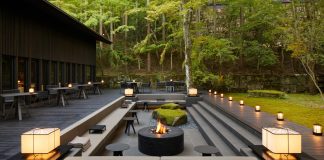How to describe northern Thailand? Let’s start with the rich cultural heritage dating back to the 13th century. Add towering mountains, languid waterfalls, swift-moving rivers, ancient temples, lush green fields, high country tea and coffee plantations, and a distinct cuisine, and you begin to get the picture.
Chiang Mai, the largest city in northern Thailand and the second most visited destination in Thailand, and Chiang Rai, a smaller sibling, are great places to base yourself when exploring this fascinating region.
Hill tribe communities are another aspect of northern Thailand’s story. Descendants of nomadic wanderers from Tibet, China, and Laos — the Lisu, Lahu, Akha, Hmong, Karen, and Mien tribes — have long called the tangled green mountains stretching along the north’s border with neighboring Myanmar (Burma) home. For centuries, they were often treated as outcasts; however, this is changing, and their unique contribution to the region’s story is being acknowledged and celebrated.
Recently I spent four weeks crisscrossing northern Thailand, gaining deeper insights, further complimenting my previous visits to this magnificent region. I prefer “slow travel,” delving into the history, understanding the location, people, and culture, connecting with locals, and making “goodwill deposits” where I can.
This article concentrates on three meaningful experiences and activities that left a stamp on my soul.
The founder of ENP, Lek Chailert
Photo credit: ENP
1. Volunteering With Rescued Elephants
The 250-acre Elephant Nature Park (ENP) sits in the verdant Mae Taeng Valley just 40 miles north of Chiang Mai. Created in 2003 by the diminutive Saengduean “Lek” Chailert, this sanctuary provides a rest-of-life home for rescued injured, neglected, and elderly Asian elephants. A native of the north, Lek has devoted her life through her Save Elephant Foundation (SEF) to advocating and championing the rights of elephants in Asia, along with all animals in need.
These majestic rescued elephants live in natural herds, going about life — grazing in the paddocks, playing in mud baths, romping in the river, and generally being elephants without any requirement to interact with, entertain, or transport humans.
Pro Tip: Take a day trip or a 2-day, 1-night visit if you’re on a tight schedule, although I recommend the 7-day volunteer stint for a fully immersive experience.

Volunteers helping staff with field work at ENP
Photo credit: ENP
Elephant Nature Park 7-Day Volunteer Program Activities
Suitable for adults of all ages, this program starts on Mondays and includes transfers from Chiang Mai. Onsite accommodation in shared same-sex rooms is provided for singles. Families or couples can stay together. The volunteer working day runs from 8 a.m. to 3 p.m., with an hour off for lunch. Three meals (tasty vegetarian) per day are provided, and volunteers contribute 12,000 THB (approx. $330 USD) for the week at ENP.
A maximum of 20 volunteers are onsite any week as extra hands to keep the necessary work happening. Food preparation is a big job, with an abundance of mouths to feed, including 118 elephants eating around 10 percent of their body weight daily, plus buffalo and hundreds of dogs and cats.
The volume of watermelons, cucumbers, sugarcane, and bananas delivered into the elephant kitchen is eye-popping.
Other tasks include cleaning elephant enclosures while they are out foraging and paddock maintenance. Some volunteers travel with staff to collect more elephant food from local farmers. Then the rescued dogs and cats need feeding, grooming, and exercising.
After the communal dinner, optional evening activities include Thai language and culture lessons or perhaps a chat with founder Lek. An equally rewarding alternative is sitting riverside chatting with fellow volunteers while listening to the sounds of elephants trumpeting across the balmy night air.

A herd of elephants at ENP
Photo credit: ENP
Most Memorable Moments
So many moments will stay with me from my rewarding Elephant Nature Park week. A particular highlight was waiting on the Mae Taeng River bank late afternoon as individual elephant herds came downriver to their enclosures for the night. Not a mahout (elephant tender) or other guiding human was involved — just each herd leader, trumpeting her compatriots to hurry along. The elephants were happily and enthusiastically heading home, having learned that some tasty treats would be waiting in their enclosures.

Traditional and organic Thai meals at the Lisu Lodge
Photo credit: Lisu Lodge
2. Hill Tribe Village Stay
Northern Thailand offers many opportunities to visit hill tribe communities, get a photo, and maybe buy a trinket. In contrast, places like Lisu Lodge, a community tourism-created venture, allow you to stay within a community for a few days, getting closer to hill tribes’ daily lives. Your stay is without any hardship while knowing that you provide direct employment for individuals and funds from the business are channeled back to the community.
Lisu Lodge sits on the outskirts of a small village, Ban Chang, in the same Mae Taeng district as Elephant Nature Park and a 50-minute drive north of Chiang Mai. The primary residents of the village are the Lisu and Akha hill tribes people, who continue to practice their culture, traditions, and way of life.

Lisu Lodge private guestroom
Photo credit: Lisu Lodge
Lodge Accommodation & Meals
The Lodge is four traditional houses set around paddy fields. A total of 20 guests can be accommodated overnight, with most visitors opting for the 2-day, 1-night stay. All guests have their own room and private bathroom. The included delicious dinner and breakfast are enjoyed communally on the expansive covered terrace, providing an opportunity to mix with fellow guests.
Having arrived and been welcomed to the Lodge, an Akha woman named Bowie took us on a guided tour of the village, providing insights into daily life. She tells us that the village shaman sometimes comes out to meet visitors.
Our exploration of Wat Ton Lung, the local Buddhist temple and its medicinal herbal garden, provided a great insight into the health benefits of herbs I’ve only associated with Thai cooking. The village’s fruit and vegetable gardens and the surrounding rice fields are organic.

Tea leaf picking excursion at the Lisu Lodge
Photo credit: Lisu Lodge
Local Excursions & Outings
Guests can grab a Lodge bicycle and explore at their own pace or sign up for one of the add-on activities. These include a nature walk with a local guide or lazily drifting down the river on a bamboo raft.
Pro Tip: One must-do excursion is visiting the nearby village-run Araksa Tea Plantation. Take the tour to learn the tea growing process and get hands on picking the fresh leaf tips. Watch how tea leaves are processed according to age-old traditions, view the factory, and sample the organically produced, award-winning teas. Stop for lunch or a snack at their café if time permits.
I loved seeing village life up close, enjoying the freshness of the delicious meals, and the Lodge staff’s friendliness plus, the rice paddies cloaked in the early morning mist. And most of all, I loved the genuineness of the whole experience.
Pro Tip: Visitors can extend beyond the typical 2-day, 1-night stay, and I recommend an extra night. Each excursion is excellent, and you’ll gain more authentic time with your host community.

The Phu Chaisai pool
Photo credit: Michael Cullen
3. Golden Triangle Luxe Eco Lodge Experience
The mountains to the north and west of Chiang Rai — dubbed the Golden Triangle by the CIA — were once known for ranking among the world’s largest opium-producing areas. That situation has turned around since the start of the 21st century, thanks in particular to Thailand’s royal family’s significant efforts.
The region is now renowned for its reforested mountains, colorful hill tribe communities, and high-value, export-quality cash crops like coffee, tea, and macadamia nuts. Mountains rise from 3,500 to 6,550 feet with narrow winding roads and fascinating villages — all well worth your time.

Outdoor dining at Phu Chaisai resort
Photo credit: Michael Cullen
A Great Base For Exploration
One possible place to base yourself for a few days while exploring the region is Phu Chaisai resort, just under an hour north of Chiang Rai. Perched atop a bamboo-clad mountain with spectacular Mae Salong valley views, Phu Chaisai, which translates as “Mountain of Clear Heart,” is an eco-lodge created by one of Thailand’s leading interior designers, M.L. Sudavdee Kriangkrai.
On land held in her family for many years, Phu Chaisai’s design harmonizes with the forested surrounds and sees split bamboo used as a strong design element. Local hill tribe fabrics add color and texture to the rooms, while the cleansing fresh mountain air reduces the need for air conditioning. Televisions and alarm clocks are absent here.
Phu Chaisai’s overall “less is more” concept provides the opportunity to immerse yourself in the natural rhythm and environment of the far north.
Hike the marked trails on this 800-acre organic estate, visit their oolong tea plantation, or learn local dishes in the cooking school using produce grown in the resort’s gardens. Experience spa treatments incorporating natural aromatic oils created from resort-grown plants. Dine on the restaurant’s authentic northern Thai, Burmese, and Akha regional cuisines, and sip the resort’s organic teas or arabica coffee from the neighboring farm.
I loved the luxury of waking up to the early morning bird song enveloped in the cool morning air, plus dining and enjoying spa treatments knowing all the elements of products served or used were natural and from the hills around me. The resort imbued a sense of peace and relaxation.
Other Things To Do Near Chiang Mai And Chiang Rai
Phu Chaisai is a great base to explore the immediate region if you have your own vehicle. Less than 20 miles from the resort is the must-visit Doi Tung Palace and the spectacular 10-acre temperate-climate Mae Fah Luang Garden.
Learn how the Royal Family, through the Doi Tung development project, positively impacted this region and its Hill Tribe communities at the Hall of Inspiration. Be tempted by their internationally awarded ceramics, textiles, and handicrafts in the boutiques, and enjoy locally grown export quality Doi Tung coffee.
When To Visit Northern Thailand
When to visit northern Thailand is worth considering. Though the busiest, November through to early February is a great time to visit as daytime temperatures are ideal and nighttime refreshingly cool. March through May is hot and often hazy due to crop burning, so not good for those with respiratory issues. June through October is the rainy season, with heavy downpours followed by sunny skies.
For more Thailand inspiration, consider
Unlock the world’s wonders with unforgettable journeys tailored just for you! Whether you crave sun-kissed beaches, thrilling adventures, or rich cultural escapes, your dream destination awaits. Enjoy seamless travel with expert tips, exclusive deals, and handpicked experiences that Turn Every Trip into a lifetime memory.










